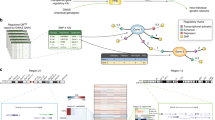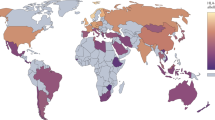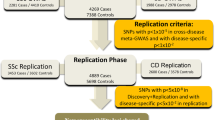Abstract
Multiple sclerosis (MS) is a chronic inflammatory disorder of the central nervous system with a strong genetic component. Several lines of evidence support a strong role for genetic factors influencing both disease susceptibility and clinical outcome in MS. Identification of genetic variants that distinguish particular disease subgroups and/or predict a severe clinical outcome is critical to further our understanding of disease mechanisms and guide development of effective therapeutic approaches. We studied 1470 MS cases and performed a genome-wide association study of more than 2.5 million single-nucleotide polymorphisms to identify loci influencing disease severity, measured using the MS severity score (MSSS), a measure of clinical disability. Of note, no single result achieved genome-wide significance. Furthermore, variants within previously confirmed MS susceptibility loci do not appear to influence severity. Although bioinformatic analyses highlight certain pathways that are over-represented in our results, we conclude that the genetic architecture of disease severity is likely polygenic and comprised of modest effects, similar to what has been described for MS susceptibility, to date. However, a role for major effects of rare variants cannot be excluded. Importantly, our results also show the MSSS, when considered as a binary or continuous phenotype variable is by comparison a stable outcome.
This is a preview of subscription content, access via your institution
Access options
Subscribe to this journal
Receive 6 digital issues and online access to articles
$119.00 per year
only $19.83 per issue
Buy this article
- Purchase on Springer Link
- Instant access to full article PDF
Prices may be subject to local taxes which are calculated during checkout




Similar content being viewed by others
References
Oksenberg JR, Barcellos LF . Multiple sclerosis genetics: leaving no stone unturned. Genes Immun 2005; 6: 375–387.
Zuvich RL, McCauley JL, Pericak-Vance MA, Haines JL . Genetics and pathogenesis of multiple sclerosis. Semin Immunol 2009; 21: 328–333.
De Jager PL, Jia X, Wang J, de Bakker PI, Ottoboni L, Aggarwal NT et al. Meta-analysis of genome scans and replication identify CD6, IRF8 and TNFRSF1A as new multiple sclerosis susceptibility loci. Nat Genet 2009; 41: 776–782.
International Multiple Sclerosis Genetics Consortium (IMSGC). Comprehensive follow-up of the first genome-wide association study of multiple sclerosis identifies KIF21B and TMEM39A as susceptibility loci. Hum Mol Genet 2010; 19: 953–962.
Oksenberg JR, Baranzini SE . Multiple sclerosis genetics—is the glass half full, or half empty? Nat Rev Neurol 2010; 6: 429–437.
Brassat D, Azais-Vuillemin C, Yaouanq J, Semana G, Reboul J, Cournu I et al. Familial factors influence disability in MS multiplex families. French Multiple Sclerosis Genetics Group. Neurology 1999; 52: 1632–1636.
Barcellos LF, Oksenberg JR, Green AJ, Bucher P, Rimmler JB, Schmidt S et al. Genetic basis for clinical expression in multiple sclerosis. Brain 2002; 125 (Part 1): 150–158.
Hensiek AE, Seaman SR, Barcellos LF, Oturai A, Eraksoi M, Cocco E et al. Familial effects on the clinical course of multiple sclerosis. Neurology 2007; 68: 376–383.
Cree BA, Khan O, Bourdette D, Goodin DS, Cohen JA, Marrie RA et al. Clinical characteristics of African Americans vs Caucasian Americans with multiple sclerosis. Neurology 2004; 63: 2039–2045.
Butterfield RJ, Blankenhorn EP, Roper RJ, Zachary JF, Doerge RW, Teuscher C . Identification of genetic loci controlling the characteristics and severity of brain and spinal cord lesions in experimental allergic encephalomyelitis. Am J Pathol 2000; 157: 637–645.
Polanczyk M, Yellayi S, Zamora A, Subramanian S, Tovey M, Vandenbark AA et al. Estrogen receptor-1 (Esr1) and -2 (Esr2) regulate the severity of clinical experimental allergic encephalomyelitis in male mice. Am J Pathol 2004; 164: 1915–1924.
Mazon Pelaez I, Vogler S, Strauss U, Wernhoff P, Pahnke J, Brockmann G et al. Identification of quantitative trait loci controlling cortical motor evoked potentials in experimental autoimmune encephalomyelitis: correlation with incidence, onset and severity of disease. Hum Mol Genet 2005; 14: 1977–1989.
Stromnes IM, Cerretti LM, Liggitt D, Harris RA, Goverman JM . Differential regulation of central nervous system autoimmunity by T(H)1 and T(H)17 cells. Nat Med 2008; 14: 337–342.
Roxburgh RH, Seaman SR, Masterman T, Hensiek AE, Sawcer SJ, Vukusic S et al. Multiple Sclerosis Severity Score: using disability and disease duration to rate disease severity. Neurology 2005; 64: 1144–1151.
Pachner AR, Steiner I . The multiple sclerosis severity score (MSSS) predicts disease severity over time. J Neurol Sci 2009; 278: 66–70.
Daumer M, Neuhaus A, Herbert J, Ebers G . Prognosis of the individual course of disease: the elements of time, heterogeneity and precision. J Neurol Sci 2009; 287 (Suppl 1): S50–S55.
Burwick RM, Ramsay PP, Haines JL, Hauser SL, Oksenberg JR, Pericak-Vance MA et al. APOE epsilon variation in multiple sclerosis susceptibility and disease severity: some answers. Neurology 2006; 66: 1373–1383.
Jensen CJ, Stankovich J, Van der Walt A, Bahlo M, Taylor BV, van der Mei IA et al. Multiple sclerosis susceptibility-associated SNPs do not influence disease severity measures in a cohort of Australian MS patients. PLoS One 2010; 5: e10003.
Johnson BA, Wang J, Taylor EM, Caillier SJ, Herbert J, Khan OA et al. Multiple sclerosis susceptibility alleles in African Americans. Genes Immun 2010; 11: 343–350.
DeLuca GC, Ramagopalan SV, Herrera BM, Dyment DA, Lincoln MR, Montpetit A et al. An extremes of outcome strategy provides evidence that multiple sclerosis severity is determined by alleles at the HLA-DRB1 locus. Proc Natl Acad Sci USA 2007; 104: 20896–20901.
Baranzini SE, Wang J, Gibson RA, Galwey N, Naegelin Y, Barkhof F et al. Genome-wide association analysis of susceptibility and clinical phenotype in multiple sclerosis. Hum Mol Genet 2009; 18: 767–778.
Brynedal B, Wojcik J, Esposito F, Debailleul V, Yaouanq J, Martinelli-Boneschi F et al. MGAT5 alters the severity of multiple sclerosis. J Neuroimmunol 2010; 220: 120–124.
Kanehisa M, Goto S . KEGG: Kyoto encyclopedia of genes and genomes. Nucleic Acids Res 2000; 28: 27–30.
Kanehisa M, Goto S, Furumichi M, Tanabe M, Hirakawa M . KEGG for representation and analysis of molecular networks involving diseases and drugs. Nucleic Acids Res 2010; 38: D355–D360.
Kanehisa M, Goto S, Hattori M, Aoki-Kinoshita KF, Itoh M, Kawashima S et al. From genomics to chemical genomics: new developments in KEGG. Nucleic Acids Res 2006; 34: D354–D357.
Pugliatti M, Rosati G, Carton H, Riise T, Drulovic J, Vecsei L et al. The epidemiology of multiple sclerosis in Europe. Eur J Neurol 2006; 13: 700–722.
Ioannidis JP, Patsopoulos NA, Evangelou E . Heterogeneity in meta-analyses of genome-wide association investigations. PLoS One 2007; 2: e841.
Sommer L, Rao M, Anderson DJ . RPTP delta and the novel protein tyrosine phosphatase RPTP psi are expressed in restricted regions of the developing central nervous system. Dev Dyn 1997; 208: 48–61.
Schaapveld RQ, Schepens JT, Bachner D, Attema J, Wieringa B, Jap PH et al. Developmental expression of the cell adhesion molecule-like protein tyrosine phosphatases LAR, RPTPdelta and RPTPsigma in the mouse. Mech Dev 1998; 77: 59–62.
Wang J, Bixby JL . Receptor tyrosine phosphatase-delta is a homophilic, neurite-promoting cell adhesion molecular for CNS neurons. Mol Cell Neurosci 1999; 14: 370–384.
Kwon SK, Woo J, Kim SY, Kim H, Kim E . Trans-synaptic adhesions between netrin-G ligand-3 (NGL-3) and receptor tyrosine phosphatases LAR, protein-tyrosine phosphatase delta (PTPdelta), and PTPsigma via specific domains regulate excitatory synapse formation. J Biol Chem 2010; 285: 13966–13978.
Uetani N, Kato K, Ogura H, Mizuno K, Kawano K, Mikoshiba K et al. Impaired learning with enhanced hippocampal long-term potentiation in PTPdelta-deficient mice. EMBO J 2000; 19: 2775–2785.
Uetani N, Chagnon MJ, Kennedy TE, Iwakura Y, Tremblay ML . Mammalian motoneuron axon targeting requires receptor protein tyrosine phosphatases sigma and delta. J Neurosci 2006; 26: 5872–5880.
Shyur SD, Wang JY, Lin CG, Hsiao YH, Liou YH, Wu YJ et al. The polymorphisms of protein-tyrosine phosphatase receptor-type delta gene and its association with pediatric asthma in the Taiwanese population. Eur J Hum Genet 2008; 16: 1283–1288.
Manconi M, Fabbrini M, Bonanni E, Filippi M, Rocca M, Murri L et al. High prevalence of restless legs syndrome in multiple sclerosis. Eur J Neurol 2007; 14: 534–539.
Manconi M, Ferini-Strambi L, Filippi M, Bonanni E, Iudice A, Murri L et al. Multicenter case–control study on restless legs syndrome in multiple sclerosis: the REMS study. Sleep 2008; 31: 944–952.
Okonkwo DO, Pettus EH, Moroi J, Povlishock JT . Alteration of the neurofilament sidearm and its relation to neurofilament compaction occurring with traumatic axonal injury. Brain Res 1998; 784: 1–6.
Khazaei MR, Bunk EC, Hillje AL, Jahn HM, Riegler EM, Knoblich JA et al. The E3-ubiquitin ligase TRIM2 regulates neuronal polarization. J Neurochem 2011; 117: 29–37.
Balastik M, Ferraguti F, Pires-da Silva A, Lee TH, Alvarez-Bolado G, Lu KP et al. Deficiency in ubiquitin ligase TRIM2 causes accumulation of neurofilament light chain and neurodegeneration. Proc Natl Acad Sci USA 2008; 105: 12016–12021.
Watanabe M, Isobe T, Ichimura T, Kuwano R, Takahashi Y, Kondo H . Molecular cloning of rat cDNAs for beta and gamma subtypes of 14-3-3 protein and developmental changes in expression of their mRNAs in the nervous system. Brain Res Mol Brain Res 1993; 17: 135–146.
Chen XQ, Yu AC . The association of 14-3-3gamma and actin plays a role in cell division and apoptosis in astrocytes. Biochem Biophys Res Commun 2002; 296: 657–663.
Ye SQ, Zhou XY, Lai XJ, Zheng L, Chen XQ . Silencing neuroglobin enhances neuronal vulnerability to oxidative injury by down-regulating 14-3-3gamma. Acta Pharmacol Sin 2009; 30: 913–918.
Dong Y, Zhao R, Chen XQ, Yu AC . 14-3-3gamma and neuroglobin are new intrinsic protective factors for cerebral ischemia. Mol Neurobiol 2010; 41: 218–231.
Ewart AK, Morris CA, Ensing GJ, Loker J, Moore C, Leppert M et al. A human vascular disorder, supravalvular aortic stenosis, maps to chromosome 7. Proc Natl Acad Sci USA 1993; 90: 3226–3230.
Komoike Y, Fujii K, Nishimura A, Hiraki Y, Hayashidani M, Shimojima K et al. Zebrafish gene knockdowns imply roles for human YWHAG in infantile spasms and cardiomegaly. Genesis 2010; 48: 233–243.
Wheeler E, Bolton C, Mullins J, Paul C . Identification of the NMDA receptor subunit inovolved in blood-brain barrier breakdown during EAE. Immunology 2002; 107 (Suppl 1): 43–47.
Bolton C, Paul C . Glutamate receptors in neuroinflammatory demyelinating disease. Mediat Inflamm 2006; 2006: 93684.
Laurie DJ, Bartke I, Schoepfer R, Naujoks K, Seeburg PH . Regional, developmental and interspecies expression of the four NMDAR2 subunits, examined using monoclonal antibodies. Brain Res Mol Brain Res 1997; 51: 23–32.
Mohrmann R, Hatt H, Gottmann K . Developmental regulation of subunit composition of extrasynaptic NMDA receptors in neocortical neurones. NeuroReport 2000; 11: 1203–1208.
Salter MG, Fern R . NMDA receptors are expressed in developing oligodendrocyte processes and mediate injury. Nature 2005; 438: 1167–1171.
Karadottir R, Cavelier P, Bergersen LH, Attwell D . NMDA receptors are expressed in oligodendrocytes and activated in ischaemia. Nature 2005; 438: 1162–1166.
Micu I, Jiang Q, Coderre E, Ridsdale A, Zhang L, Woulfe J et al. NMDA receptors mediate calcium accumulation in myelin during chemical ischaemia. Nature 2006; 439: 988–992.
Groc L, Heine M, Cousins SL, Stephenson FA, Lounis B, Cognet L et al. NMDA receptor surface mobility depends on NR2A-2B subunits. Proc Natl Acad Sci USA 2006; 103: 18769–18774.
Turic D, Langley K, Mills S, Stephens M, Lawson D, Govan C et al. Follow-up of genetic linkage findings on chromosome 16p13: evidence of association of N-methyl-Daspartate glutamate receptor 2A gene polymorphism with ADHD. Mol Psychiatry 2004; 9: 169–173.
Barnby G, Abbott A, Sykes N, Morris A, Weeks DE, Mott R et al. Candidate-gene screening and association analysis at the autism-susceptibility locus on chromosome 16p: evidence of association at GRIN2A and ABAT. Am J Hum Genet 2005; 76: 950–966.
Tang J, Chen X, Xu X, Wu R, Zhao J, Hu Z et al. Significant linkage and association between a functional (GT)n polymorphism in promoter of the N-methyl-D-aspartate receptor subunit gene (GRIN2A) and schizophrenia. Neurosci Lett 2006; 409: 80–82.
Arning L, Kraus PH, Valentin S, Saft C, Andrich J, Epplen JT . NR2A and NR2B receptor gene variations modify age at onset in Huntington disease. Neurogenetics 2005; 6: 25–28.
Arning L, Saft C, Wieczorek S, Andrich J, Kraus PH, Epplen JT . NR2A and NR2B receptor gene variations modify age at onset in Huntington disease in a sex-specific manner. Hum Genet 2007; 122: 175–182.
Andresen JM, Gayan J, Cherny SS, Brocklebank D, Alkorta-Aranburu G, Addis EA et al. Replication of twelve association studies for Huntington's disease residual age of onset in large Venezuelan kindreds. J Med Genet 2007; 44: 44–50.
Consortium ITIMSG. IL12A, MPHOSPH9/CDK2AP1 and RGS1 are novel multiple sclerosis susceptibility loci. Genes Immun 2010; 11: 397–405.
McDonald WI, Compston A, Edan G, Goodkin D, Hartung HP, Lublin FD et al. Recommended diagnostic criteria for multiple sclerosis: guidelines from the International Panel on the diagnosis of multiple sclerosis. Ann Neurol 2001; 50: 121–127.
Hafler DA, Compston A, Sawcer S, Lander ES, Daly MJ, De Jager PL et al. Risk alleles for multiple sclerosis identified by a genomewide study. N Engl J Med 2007; 357: 851–862.
Efron E, Tibshirani RJ . An Introduction to the Bootstrap. Chapman & Hall/CRC: New York, 1993.
Zhang B, Kirov S, Snoddy J . WebGestalt: an integrated system for exploring gene sets in various biological contexts. Nucleic Acids Res 2005; 33: W741–W748.
Acknowledgements
This work was supported by the National Institutes of Health (NS049477, NS032830, MH065215, NS067305, AI076544), the Wellcome Trust (084702/Z/08/Z) and the Cambridge NIHR Biomedical Research Centre. We appreciated the many helpful comments and suggestions from Paola Bronson and Patricia P Ramsay. All study participants were recruited in agreement with protocols of the institutional review board at each institution. For a full list of members of the IMSGC, see http://www.imsgc.org/.
Author contributors: Contributing authors to this work are Farren BS Briggs (UC Berkeley), Xiaorong Shao (UC Berkeley), Benjamin A Goldstein (UC Berkeley), Jorge R Oksenberg (UC San Francisco), Lisa F Barcellos (UC Berkeley) and Philip L de Jager (Brigham & Women's Hospital and Harvard Medical School). LFB and PLD contributed equally to this work. PLD is a Harry Weaver Neuroscience Scholar of the National MS Society. FBSB is a National MS Society Postdoctoral Fellow.
Author information
Consortia
Ethics declarations
Competing interests
The authors declare no conflict of interest.
Additional information
Contributors Farren BS Briggs Genetic Epidemiology and Genomics Laboratory, Division of Epidemiology, School of Public Health, UC Berkeley. Xiaorong Shao Genetic Epidemiology and Genomics Laboratory, Division of Epidemiology, School of Public Health, UC Berkeley; Division of Biostatistics, School of Public Health, UC Berkeley. Benjamin A Goldstein Genetic Epidemiology and Genomics Laboratory, Division of Epidemiology, School of Public Health, UC Berkeley; Division of Biostatistics, School of Public Health, UC Berkeley. Jorge R Oksenberg Department of Neurology, School of Medicine, UC San Francisco; Institute for Human Genetics, School of Medicine, UC San Francisco. Lisa F Barcellos Genetic Epidemiology and Genomics Laboratory, Division of Epidemiology, School of Public Health, UC Berkeley. Philip L De Jager Program in NeuroPsychiatric Genomics, Center for Neurologic Diseases, Department of Neurology, Brigham & Women's Hospital, Boston; Program in Medical & Population Genetics, Broad Institute of Harvard University and Massachusetts Institute of Technology, Cambridge, MA.
Supplementary Information accompanies the paper on Genes and Immunity website ()
Supplementary information
Rights and permissions
About this article
Cite this article
International Multiple Sclerosis Genetics Consortium. Genome-wide association study of severity in multiple sclerosis. Genes Immun 12, 615–625 (2011). https://doi.org/10.1038/gene.2011.34
Received:
Accepted:
Published:
Issue Date:
DOI: https://doi.org/10.1038/gene.2011.34
Keywords
This article is cited by
-
Genome-wide study of longitudinal brain imaging measures of multiple sclerosis progression across six clinical trials
Scientific Reports (2023)
-
The immunology of multiple sclerosis
Nature Reviews Immunology (2022)
-
Quantitative MRI phenotypes capture biological heterogeneity in multiple sclerosis patients
Scientific Reports (2021)
-
Contribution of common risk variants to multiple sclerosis in Orkney and Shetland
European Journal of Human Genetics (2021)
-
HLA genotype-clinical phenotype correlations in multiple sclerosis and neuromyelitis optica spectrum disorders based on Japan MS/NMOSD Biobank data
Scientific Reports (2021)



